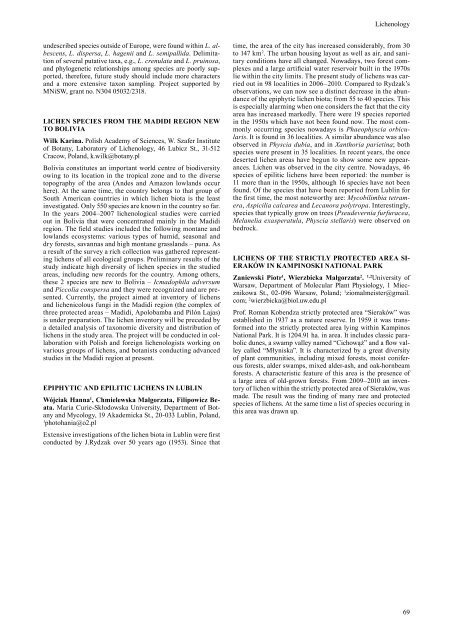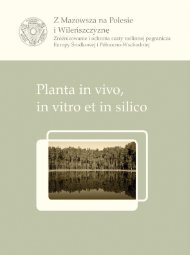acta societatis botanicorum poloniae - LV Zjazd Polskiego ...
acta societatis botanicorum poloniae - LV Zjazd Polskiego ...
acta societatis botanicorum poloniae - LV Zjazd Polskiego ...
Create successful ePaper yourself
Turn your PDF publications into a flip-book with our unique Google optimized e-Paper software.
undescribed species outside of Europe, were found within L. albescens,<br />
L. dispersa, L. hagenii and L. semipallida. Delimitation<br />
of several putative taxa, e.g., L. crenulata and L. pruinosa,<br />
and phylogenetic relationships among species are poorly supported,<br />
therefore, future study should include more characters<br />
and a more extensive taxon sampling. Project supported by<br />
MNiSW, grant no. N304 05032/2318.<br />
LICHEN SPECIES FrOM THE MAdIdI rEGION NEW<br />
TO BOLIVIA<br />
Wilk Karina. Polish Academy of Sciences, W. Szafer Institute<br />
of Botany, Laboratory of Lichenology, 46 Lubicz St., 31-512<br />
Cracow, Poland, k.wilk@botany.pl<br />
Bolivia constitutes an important world centre of biodiversity<br />
owing to its location in the tropical zone and to the diverse<br />
topography of the area (Andes and Amazon lowlands occur<br />
here). At the same time, the country belongs to that group of<br />
South American countries in which lichen biota is the least<br />
investigated. Only 550 species are known in the country so far.<br />
In the years 2004–2007 lichenological studies were carried<br />
out in Bolivia that were concentrated mainly in the Madidi<br />
region. The field studies included the following montane and<br />
lowlands ecosystems: various types of humid, seasonal and<br />
dry forests, savannas and high montane grasslands – puna. As<br />
a result of the survey a rich collection was gathered representing<br />
lichens of all ecological groups. Preliminary results of the<br />
study indicate high diversity of lichen species in the studied<br />
areas, including new records for the country. Among others,<br />
these 2 species are new to Bolivia – Icmadophila adversum<br />
and Piccolia conspersa and they were recognized and are presented.<br />
Currently, the project aimed at inventory of lichens<br />
and lichenicolous fungi in the Madidi region (the complex of<br />
three protected areas – Madidi, Apolobamba and Pilón Lajas)<br />
is under preparation. The lichen inventory will be preceded by<br />
a detailed analysis of taxonomic diversity and distribution of<br />
lichens in the study area. The project will be conducted in collaboration<br />
with Polish and foreign lichenologists working on<br />
various groups of lichens, and botanists conducting advanced<br />
studies in the Madidi region at present.<br />
EPIPHYTIC ANd EPILITIC LICHENS IN LUBLIN<br />
Wójciak Hanna 1 , Chmielewska Małgorzata, Filipowicz Beata.<br />
Maria Curie-Skłodowska University, Department of Botany<br />
and Mycology, 19 Akademicka St., 20-033 Lublin, Poland,<br />
1 photohania@o2.pl<br />
Extensive investigations of the lichen biota in Lublin were first<br />
conducted by J.Rydzak over 50 years ago (1953). Since that<br />
Lichenology<br />
time, the area of the city has increased considerably, from 30<br />
to 147 km 2 . The urban housing layout as well as air, and sanitary<br />
conditions have all changed. Nowadays, two forest complexes<br />
and a large artificial water reservoir built in the 1970s<br />
lie within the city limits. The present study of lichens was carried<br />
out in 98 localities in 2006– 2010. Compared to Rydzak’s<br />
observations, we can now see a distinct decrease in the abundance<br />
of the epiphytic lichen biota; from 55 to 40 species. This<br />
is especially alarming when one considers the fact that the city<br />
area has increased markedly. There were 19 species reported<br />
in the 1950s which have not been found now. The most commonly<br />
occurring species nowadays is Phaeophyscia orbicularis.<br />
It is found in 36 localities. A similar abundance was also<br />
observed in Physcia dubia, and in Xanthoria parietina; both<br />
species were present in 35 localities. In recent years, the once<br />
deserted lichen areas have begun to show some new appearances.<br />
Lichen was observed in the city centre. Nowadays, 46<br />
species of epilitic lichens have been reported: the number is<br />
11 more than in the 1950s, although 16 species have not been<br />
found. Of the species that have been reported from Lublin for<br />
the first time, the most noteworthy are: Mycobilimbia tetramera,<br />
Aspicilia calcarea and Lecanora polytropa. Interestingly,<br />
species that typically grow on trees (Pseudevernia furfuracea,<br />
Melanelia exasperatula, Physcia stellaris) were observed on<br />
bedrock.<br />
LICHENS OF THE STrICTLY PrOTECTEd ArEA SI-<br />
ERAKóW IN KAMPINoSKI NAtIoNAL PARK<br />
Zaniewski Piotr 1 , Wierzbicka Małgorzata 2 . 1,2 University of<br />
Warsaw, Department of Molecular Plant Physiology, 1 Miecznikowa<br />
St., 02-096 Warsaw, Poland; 1 ziomalmeister@gmail.<br />
com; 2 wierzbicka@biol.uw.edu.pl<br />
Prof. Roman Kobendza strictly protected area “Sieraków” was<br />
established in 1937 as a nature reserve. In 1959 it was transformed<br />
into the strictly protected area lying within Kampinos<br />
National Park. It is 1204.91 ha. in area. It includes classic parabolic<br />
dunes, a swamp valley named “Cichowąż” and a flow valley<br />
called “Młyniska”. It is characterized by a great diversity<br />
of plant communities, including mixed forests, moist coniferous<br />
forests, alder swamps, mixed alder-ash, and oak-hornbeam<br />
forests. A characteristic feature of this area is the presence of<br />
a large area of old-grown forests. From 2009– 2010 an inventory<br />
of lichen within the strictly protected area of Sieraków, was<br />
made. The result was the finding of many rare and protected<br />
species of lichens. At the same time a list of species occuring in<br />
this area was drawn up.<br />
69



